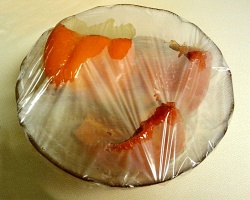We hope the uncontrolled nuclear chain reactions the plant is experiencing are Cold Fusion, as our experience with Saran Wrap is that it tends to melt in the microwave in under 30 seconds.
From Kyodo
Gov't eyes use of huge sheet to contain radioactive substances
TOKYO, April 4, Kyodo
The government has asked Tokyo Electric Power Co., operator of the crippled Fukushima Daiichi nuclear plant, to study the possibility of containing radioactive substances from four damaged reactors by wrapping their entire containment buildings with a huge amount of sheeting, government sources said Sunday.The proposal calls for building framed structures around the 45-meter-high containment buildings and then wrapping them with the sheeting, the sources said.
If all of the four buildings were wrapped in this manner, it would cost about 80 billion yen and take up to two months, the sources said.
But atomic energy experts are skeptical about the feasibility of the plan, proposed by a general construction firm, saying the step would have only limited effects in blocking the release of radioactive substances into the environment.
Osaka University professor emeritus Keiji Miyazaki said that there is the risk that such sheeting would be torn apart by heat emanating from nuclear reactors. ''What must be done speedily is rather the restoration of the reactors' cooling functions,'' said the professor of atomic energy engineering.
Ritsumeikan University professor emeritus Ikuro Anzai said if sheeting-based containment were technically possible, it would help block the release of radioactive substances into the atmosphere and the ground.
But the professor, who specializes in ways to protect humans from radiation exposure, added that there is the risk that radiation levels would go up inside the sheeting, thus hampering various restoration work, including the work to spray water onto the reactors.
A source close to the government criticized its latest move, saying, ''Politicians and the TEPCO management adopted the proposal from the major construction company which does not have deep knowledge about nuclear power plants.''
''This step is essentially lip service to give the public a sense of ease by hiding the image of the decrepit nuclear plant,'' the source said.
==Kyodo
